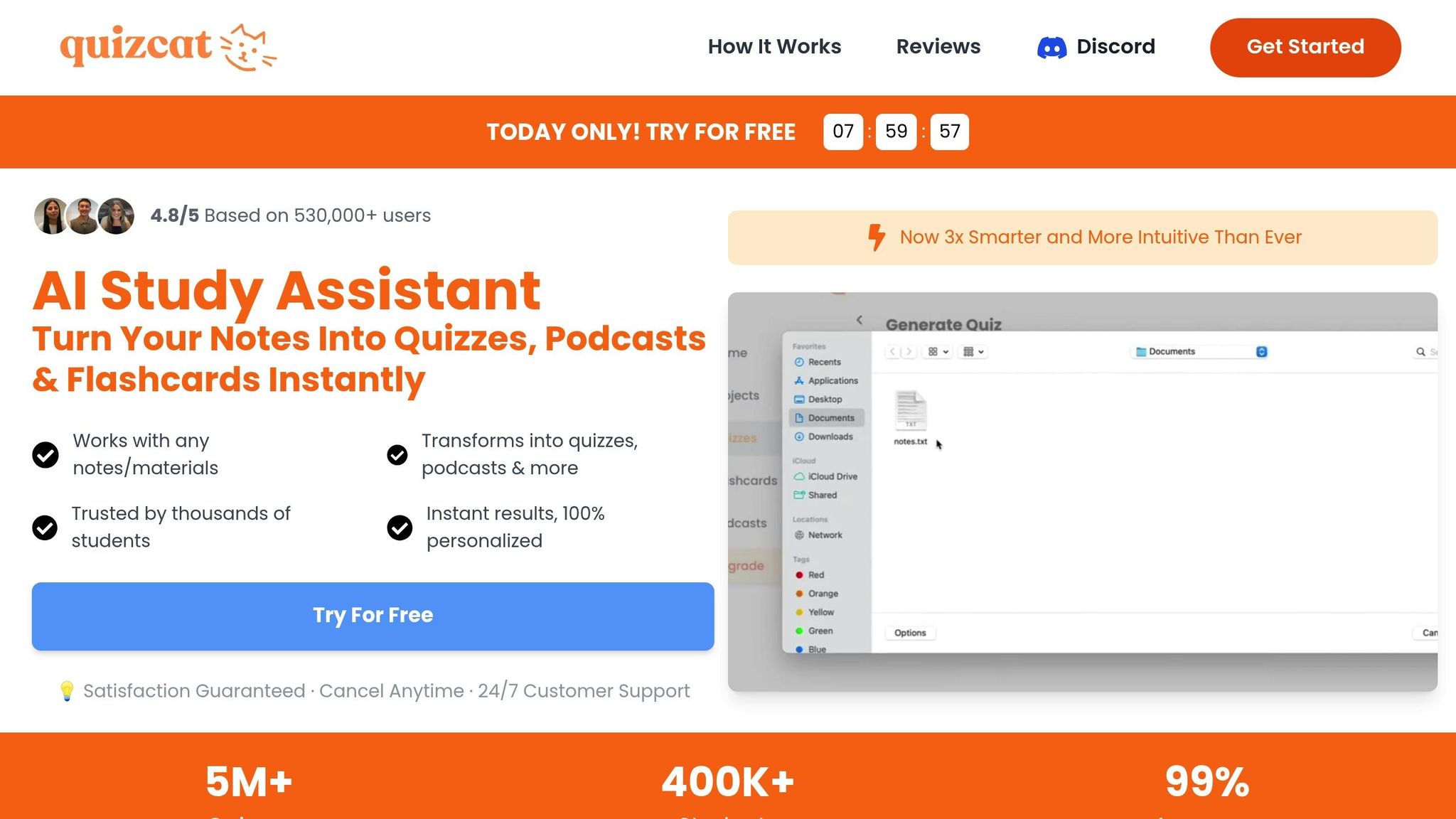
How AI Analyzes Peer Interaction for Better Matches
AI simplifies group learning by analyzing how students interact to form better-matched study groups. It looks at communication styles, learning habits, and academic strengths to create groups that work well together. Here's what you should know:
-
Key Features:
- Matches based on learning styles, schedules, and subject expertise.
- Tracks engagement and adapts groups in real time.
- Uses tools like QuizCat AI to turn notes into quizzes, flashcards, and podcasts.
-
How It Works:
- Collects data on response times, participation, and quiz performance.
- Uses AI techniques like clustering and predictive modeling to pair students.
- Continuously monitors group dynamics and adjusts as needed.
-
Results:
- Improved test scores and study habits.
- 99% accuracy in content analysis with tools like QuizCat AI.
- High user satisfaction (4.8/5 from over 530,000 users).
AI-powered tools like QuizCat AI are transforming collaborative learning by making study groups more effective and personalized.
Types of Peer Interaction Data
Core Interaction Metrics
AI systems rely on specific interaction metrics to pair students effectively. These metrics shed light on how students engage with learning materials and each other:
- Response times and message frequency: Tracks how quickly and often students reply during interactions.
- Response depth: Assessed through word count and how relevant responses are to the topic.
- Session attendance and participation rates: Measures consistency and involvement in group activities.
- Quiz performance and progress: Monitors scores and improvement over time.
- Study duration and preparation time: Evaluates how much effort students dedicate outside of sessions.
QuizCat AI highlights a strong connection between active participation and better retention rates. Let's explore how this data is gathered.
Data Collection Methods
Modern AI platforms use multiple tools to collect peer interaction data:
-
Automated Session Tracking
Platforms analyze session data, such as:- Duration of sessions
- Speaking time distribution
- Frequency of resource sharing
- Patterns in Q&A exchanges
-
Interactive Feedback Systems
Feedback mechanisms refine the matching process by collecting insights through:- Post-session surveys
- Self-assessed progress reports
- Peer evaluations
- Learning style questionnaires
-
Behavioral Analytics
Behavioral data provides deeper insights through metrics like:Behavior Type Metrics Matching Impact Communication Style Message frequency, response time Matches students with compatible communication styles Resource Utilization Use and sharing of study materials Identifies students who manage resources effectively Participation Balance Speaking time, contribution frequency Promotes balanced group dynamics Schedule Adherence Attendance and punctuality Aligns students with similar time commitments
This robust data collection framework plays a critical role in enabling AI to create effective and well-matched study groups.
AI Methods for Match Analysis
Data Filtering and Modeling
AI leverages advanced techniques like clustering and collaborative filtering to process and analyze peer data effectively. Here's a breakdown of how it works:
| Data Type | AI Analysis Method | Matching Impact |
|---|---|---|
| Academic Background | Collaborative Filtering | Matches students based on knowledge gaps |
| Learning Style | Clustering Analysis | Groups students with similar study approaches |
| Participation Metrics | Social Network Analysis | Balances active and passive learners |
| Quiz Performance | Predictive Modeling | Aligns students to address knowledge gaps |
Research from USC highlights how AI can analyze social ties and behavioral patterns to create optimized groupings.
Text Analysis in Matching
AI doesn't stop at numbers - it dives into qualitative data too. Using Natural Language Processing (NLP), it deciphers communication patterns to refine matches further. The system evaluates:
- The relevance of message content
- Frequency and consistency of communication
- Writing style compatibility
- Use of technical vocabulary
In a study involving 110 university students, AI identified three key interaction profiles: active questioners, responsive navigators, and silent listeners. By categorizing students this way, AI helps form balanced groups where different communication styles work together effectively.
Real-Time Match Updates
AI doesn't just set up groups and walk away - it continuously monitors and fine-tunes matches to adapt to changing dynamics. Here's how it stays on top of things:
-
Engagement Metrics
It tracks participation, response times, and resource sharing. If engagement dips, the system adjusts group compositions. -
Feedback Integration
Both explicit feedback (like surveys) and implicit data (like interaction patterns) are used to refine group matches. -
Performance Tracking
Tools like QuizCat AI monitor quiz scores and study behaviors, ensuring that knowledge gaps are addressed efficiently.
This ongoing adaptability allows AI to respond quickly to shifts in group dynamics, helping to create a more effective and supportive learning environment.
Results of AI-Based Matching
Group Learning Results
Students have seen clear improvements in both test scores and study habits when placed in AI-matched study groups. Maya Johnson shared her perspective:
"Uploading my notes and instantly having quizzes ready feels like magic. This tool has completely changed the way I study. I actually feel prepared for once!"
These outcomes are further supported by QuizCat AI, which brings in advanced tools to make collaborative learning even more effective.
Integration with QuizCat AI

QuizCat AI takes study materials and turns them into interactive quizzes, flashcards, and even podcasts to make group learning more dynamic. With over 400,000 active students and more than 5 million quizzes generated, QuizCat AI provides tools that cater to a variety of learning styles.
Here’s what makes the integration stand out:
- Synchronized Learning: Group members can share automatically generated study materials, ensuring everyone stays on the same page.
-
Multi-Modal Learning Support: The platform transforms study materials into formats like flashcards and podcasts, making it easier to match different preferences. Ethan Blake shared his thoughts:
"The flashcards are crazy good, but the podcast feature is my fave. It reads my notes back to me while I'm at the gym or driving. Talk about multitasking!"
- Real-Time Progress Tracking: With a 99% accuracy rate, QuizCat AI monitors both group progress and individual contributions, earning a 4.8/5 rating from over 530,000 users.
sbb-itb-1e479da
Privacy and Ethics in AI Matching
Data Security Methods
Educational platforms prioritize protecting sensitive information by implementing strict, multi-layered security measures that comply with FERPA regulations.
Here are some key methods used to safeguard data:
| Security Layer | Method | Purpose |
|---|---|---|
| End-to-End Encryption | AES-256 encryption | Keeps data secure during transmission and storage |
| Access Controls | Role-based permissions | Ensures only authorized personnel can view specific data |
| Data Anonymization | Pseudonymization techniques | Strips personally identifiable information from datasets |
| Security Monitoring | Threat detection | Identifies and addresses potential breaches in real time |
Regular security audits and penetration tests are essential to uncover vulnerabilities. These measures not only protect data but also lay the groundwork for trustworthy AI decision-making processes.
Clear AI Decision-Making
AI matching systems gain student trust by being transparent about how decisions are made, using clear explanations and visual aids to demystify the process.
Here’s how transparency is achieved:
-
Explainable Decisions
Students are provided with straightforward explanations of the criteria used for group formation, such as academic strengths, learning preferences, and schedule compatibility. -
User Control
Students have the ability to review the data being used in the matching process and can adjust it through detailed privacy settings. -
Ethical Oversight
Independent ethics committees oversee AI implementations to reduce bias and promote fairness.
Using AI to Optimize Admissions with Elizabeth Kirby
Conclusion: Next Steps in AI Matching
AI-driven peer matching is steadily advancing, reshaping how collaborative learning unfolds. The future of this technology focuses on three main areas: personalization, integration, and data-driven advancements.
Enhanced Personalization
AI systems are getting better at identifying and adapting to individual learning patterns. By refining how groups are formed, these systems aim to align learners based on compatibility, engagement levels, and learning styles. For example, with more than 5 million quizzes generated, these tools are constantly fine-tuning peer matches to meet specific learning goals.
Seamless Integration
More educational institutions are embracing AI-powered tools to enrich their learning environments. This integration not only supports diverse and inclusive classrooms but also ensures that data security and ethical considerations - key topics previously discussed - remain a priority.
Data-Driven Advancements
Modern platforms are setting new benchmarks with a 99% accuracy rate in content analysis. Their ability to process different types of study materials and transform them into dynamic, interactive tools underscores the potential for even greater progress in collaborative learning systems.
FAQs
How does AI create study groups that foster effective collaboration?
AI examines peer interaction data by looking at things like how individuals communicate, their learning styles, and their areas of expertise. By analyzing these factors, it identifies strengths that complement one another and works to create balanced group dynamics.
This approach helps assemble study groups where members can support each other effectively, fostering collaboration and boosting overall learning potential.
How does AI ensure student data is protected and privacy is maintained during peer matching?
AI systems that support peer matching prioritize student privacy and data security above all else. They rely on advanced encryption to protect personal information, ensuring that sensitive data remains accessible only to authorized users.
To further safeguard identities, these systems often anonymize data during analysis. This allows the AI to evaluate interaction patterns and create effective matches without revealing personal details. By following strict privacy guidelines and adhering to compliance regulations, these systems provide students with a secure and reliable experience.
How does QuizCat AI use your study materials to improve learning?
QuizCat AI transforms your uploaded notes or study materials into interactive learning tools such as quizzes, flashcards, and even podcasts. These tools are crafted to help you revisit important concepts, assess your understanding, and zero in on areas where you might need extra practice.
Whether you're gearing up for an exam or diving into a new subject, QuizCat AI tailors your study sessions to make learning both enjoyable and efficient.
